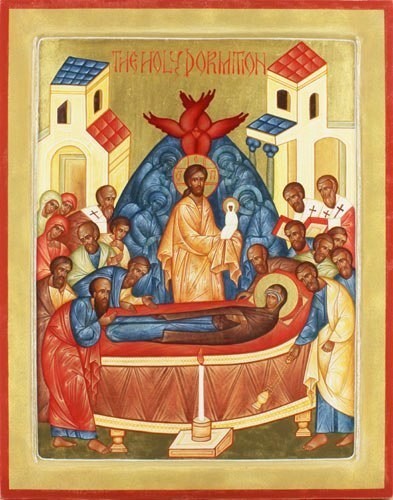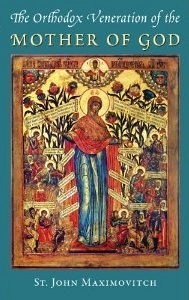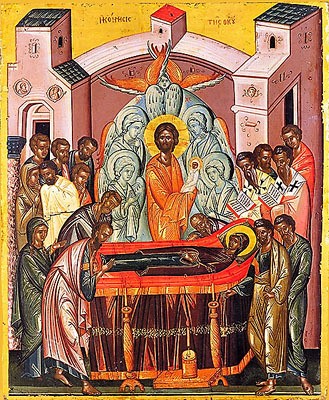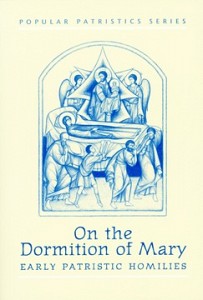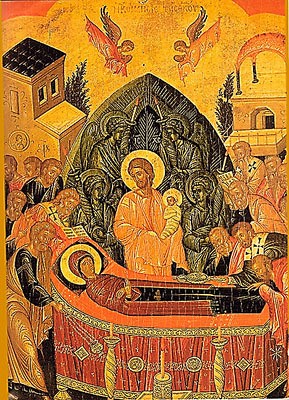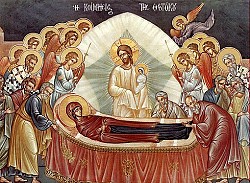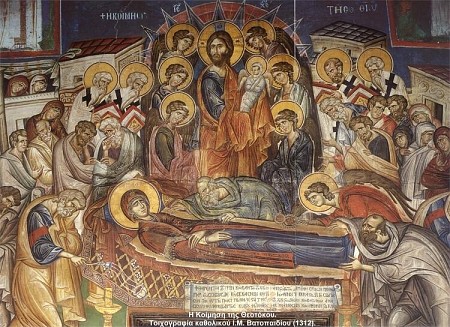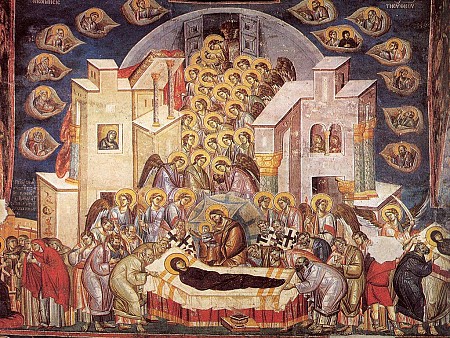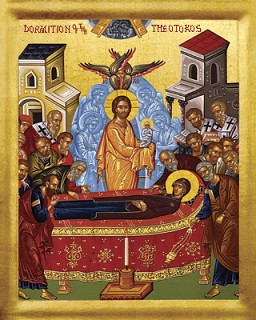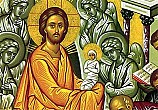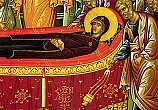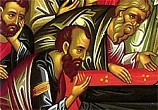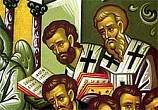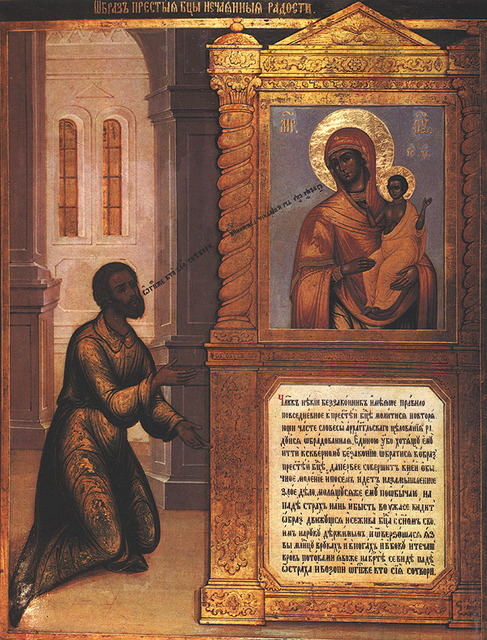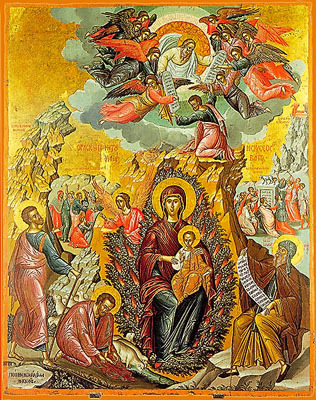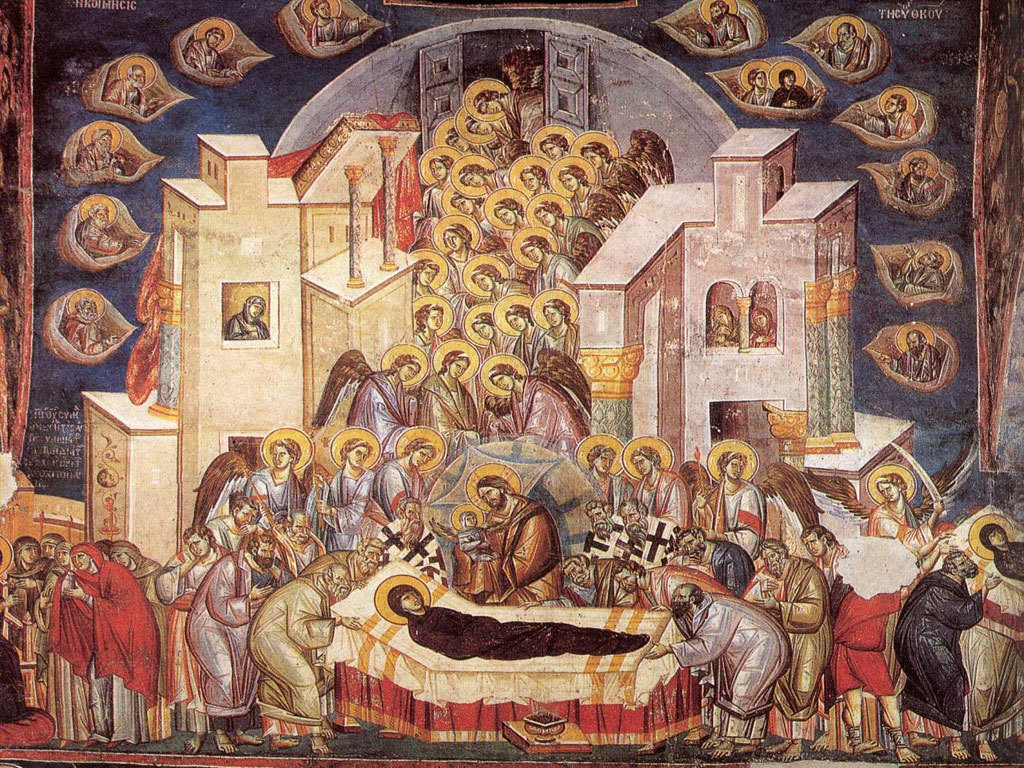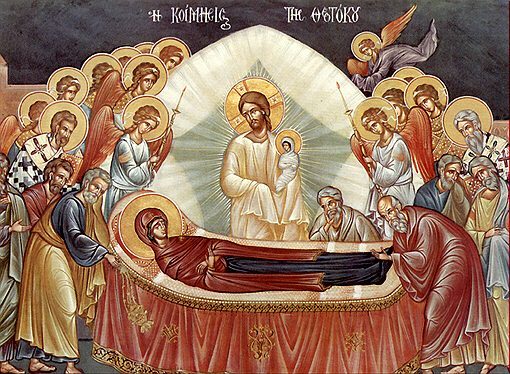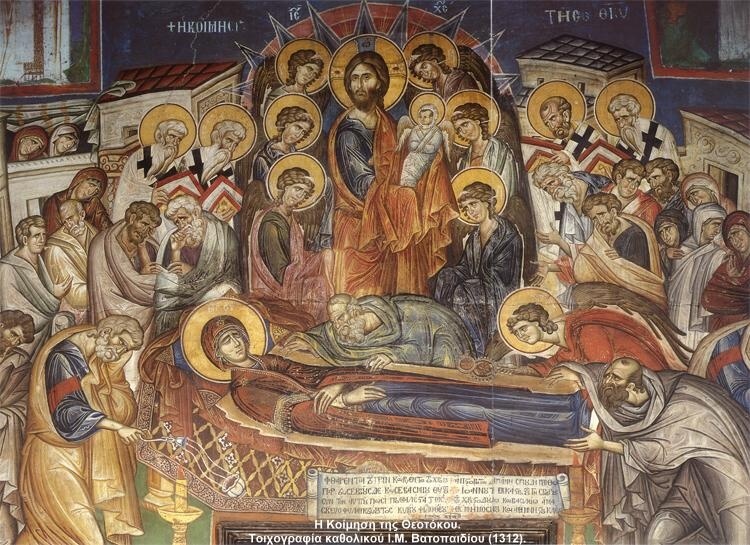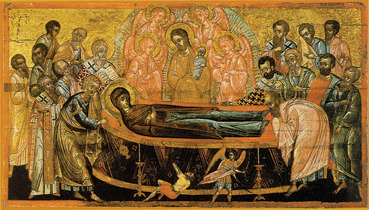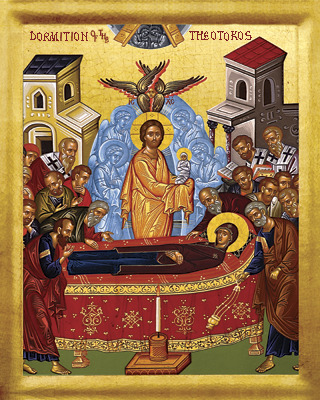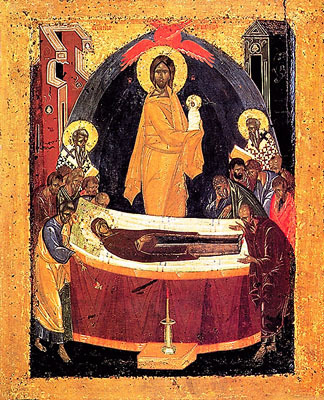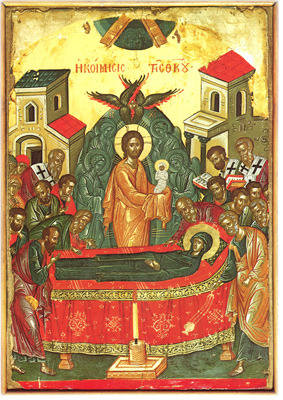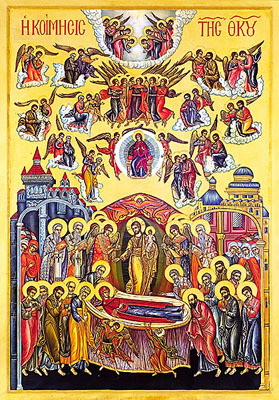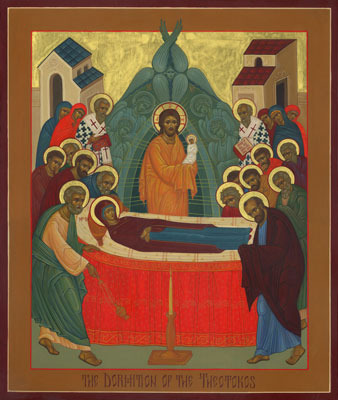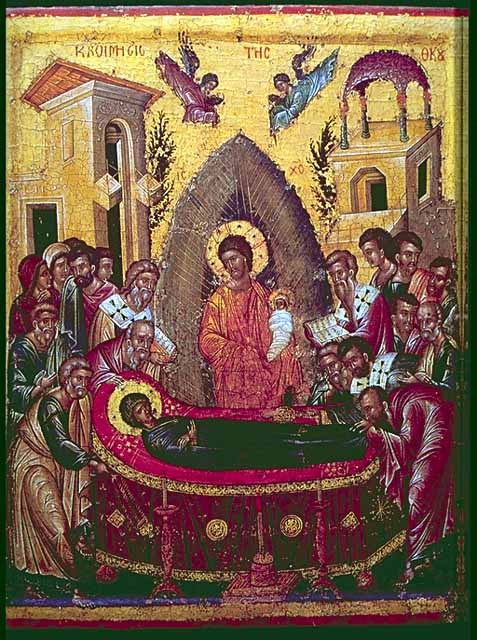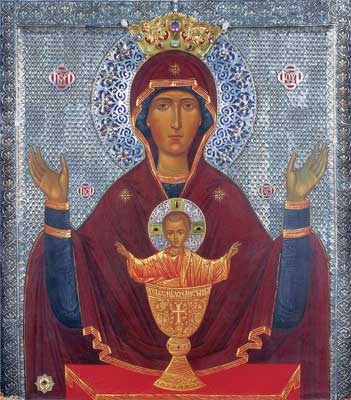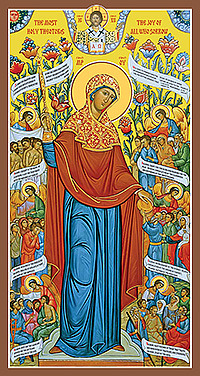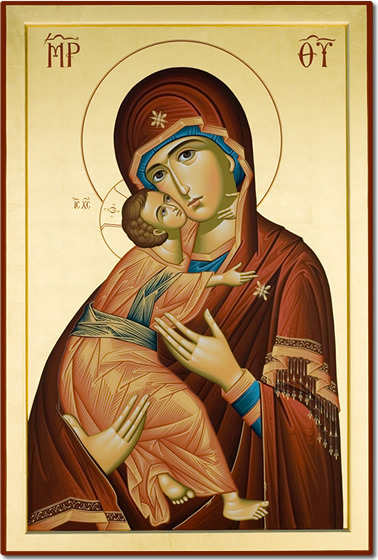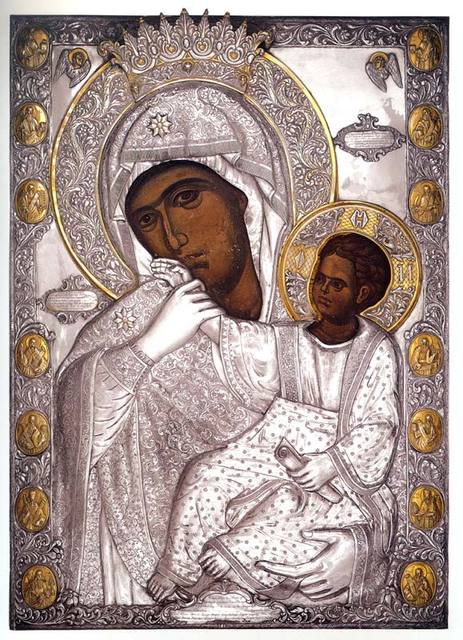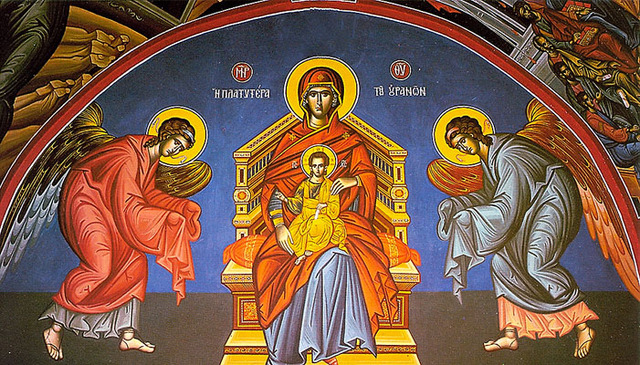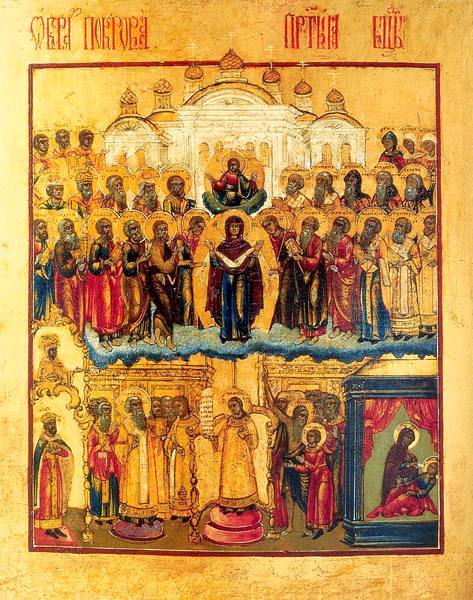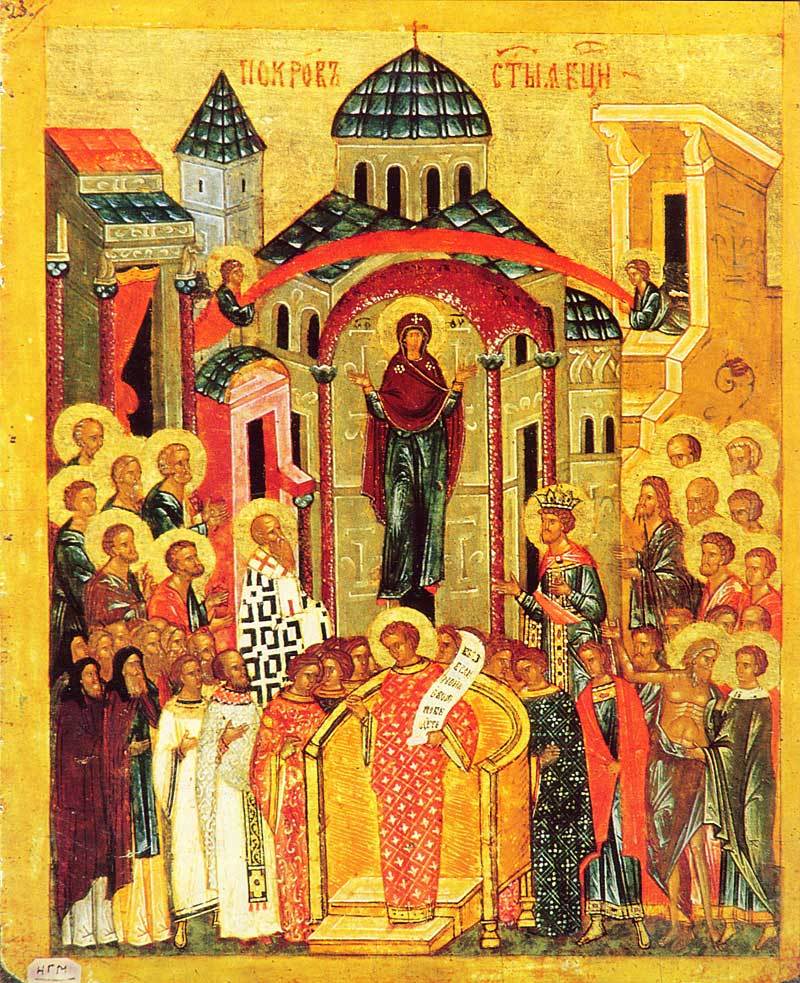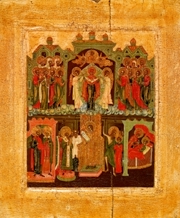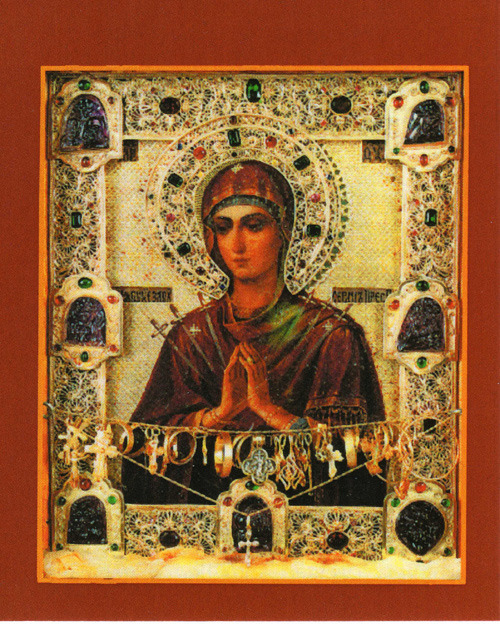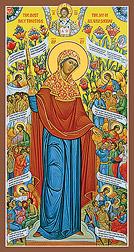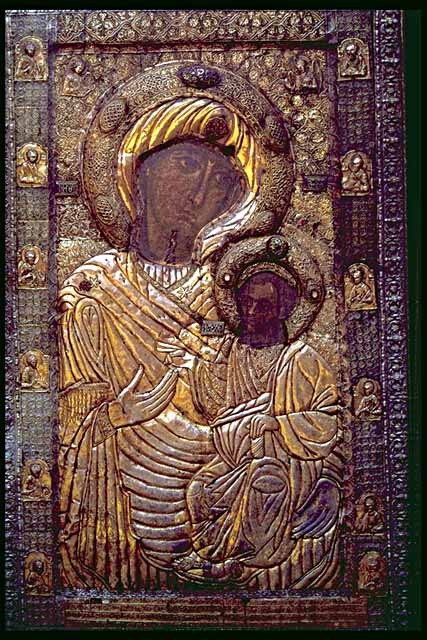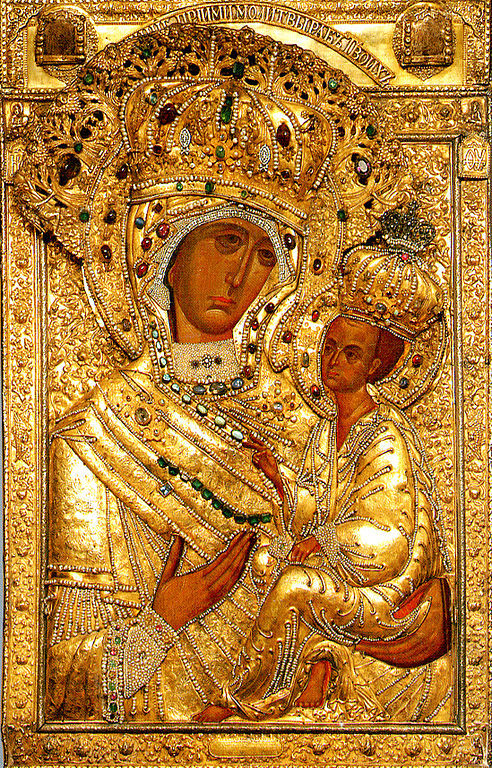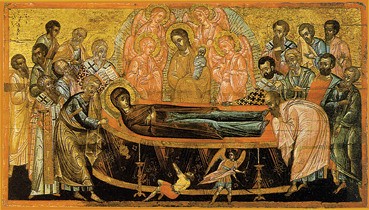Dormition of the Theotokos - August 15
2024 Schedule
Dormition Fast: August 1-14
Festal Schedule:
- Monday, August 12, 7:00pm - Vespers
- Tuesday, August 13, 9:00pm - Compline
- Wednesday, August 14, 6:00pm Vesperal Divine Liturgy
Scroll down for Festal Resources
Scroll down for articles, icons and suggested books on the Theotokos and her Falling Asleep and Translation to Heaven, with new patristic resources.
Be sure to also visit our special resource pages on the Transfiguration of the Lord (Aug 6) and on St Herman of Alaska (Aug 9).
In giving birth you preserved your virginity,
In falling asleep you did not forsake the world, O Theotokos.
You were translated to life, O Mother of Life,
And by your prayers, you deliver our souls from death.
Kontakion - Tone 2
Neither the tomb, nor death could hold the Theotokos,
Who is constant in prayer and our firm hope in her intercessions.
For being the Mother of Life,
She was translated to life by the One who dwelt in her virginal womb.
Links provided for quick selection and ordering.
- Mary, the Mother of God, Sermons by St. Gregory Palamas
- Celebration of Faith vol. III: The Virgin Mary by Fr. Alexander Schemmann
- The Orthodox Veneration of Mary, the Birthgiver of God, by St. John Maximovich
- Mary - The Untrodden Portal of God by George Gabriel
- On the Dormition of Mary - Various Patristic Homilies on the Feast, ed. by Daley
- On the Mother of God by Jacob of Serug
- Wider Than Heaven - Eighth Century Homilies on the Mother of God, ed. and translated by Mary Cunningham
FIRST TIME IN ENGLISH
St Maximus the Confessor's
The LIFE of the VIRGIN
- Translated, with Introduction and Notes by Stephen J. Shoemaker
- Yale University Press, 2012
PUBLISHER'S DESCRIPTION:
Long overlooked by scholars, this seventh-century Life of the Virgin, attributed to Maximus the Confessor, is the earliest complete Marian biography. Originally written in Greek and now surviving only in Old Georgian, it is now translated for the first time into English. It is a work that holds profound significance for understanding the history of late ancient and medieval Christianity, providing a rich source for understanding the history of Christian piety.
The Life of the Virgin is especially remarkable for its representation of Mary's prominent involvement in her son's ministry and her leadership of the early Christian community. In particular, it reveals highly developed devotion to Mary's compassionate suffering at the Crucifixion, anticipating by several centuries an influential medieval style of devotion known as "affective piety" whose origins generally have been confined to the Western High Middle Ages.
ORDER ONLINE:
- Amazon.com: Hardcover, $29.41 — Kindle Edition, $19.25
- ChristianBook.com: Hardcover, $26.99
The Life of the Virgin Mary, the Theotokos
By Holy Apostles Convent
The most complete text on the life of the Mother of God from her Conception to her Dormition and bodily translation, including her role in the Church, treated within the framework of Sacred Scriptures, Holy Tradition, Patristics and other ancient writings, together with the Liturgical and Iconographic Traditions of the Holy Orthodox Church.
This hardbound text is well-illustrated with many icons, sketches, photos, and 4 maps. The 640 page book has a gold-stamped burgundy hardcover, with acid-free pages.
Chapters Include:
- The Conception by Righteous Anna of the Virgin Mary
- The Nativity of the Virgin Mary
- The Entrance of the Virgin Mary Into the Temple
- The Virgin Growing Up in the Temple
- The Virgin Comes of Age
- The Annunciation of the Mother of God and Ever-Virgin Mary
- The Mother of God Visits Righteous Elisabeth
- Joseph Reproaches the Mother of God
- The Nativity According to the Flesh of Our Lord, God and Saviour, Jesus Christ
- Wise Men Out of the East
- The Circumcision of Our Lord Jesus Christ, in the Flesh
- The Meeting of Our Lord and God and Saviour Jesus Christ, in the Temple
- The Massacre of 14,000 Infants in Bethlehem and Its Borders
- The Flight Into Egypt
- Daily Life
- Christ at Twelve Years Old in the Temple
- The Repose of the Righteous Elder Joseph
- The Marriage at Cana
- Christ Shows Who is His Mother, Brother and Sister
- Christ Shows Who is Blessed
- The Passion of Our Lord Jesus Christ
- The Theotokos and the Myrrh-bearers: Mary Magdalene, Mary, Joanna, Salome, Susanna, Mary and Martha
- The Ascension of Our Lord Jesus Christ
- The Descent of the Holy Spirit on the Pentecost
- The Early Years of the Church in Jerusalem
- The Theotokos on Mount Athos
- The Theotokos Returns to Jerusalem
- The Dormition of Our Most Holy Lady the Theotokos and Ever-Virgin Mary
- The Theotokos is Bodily Translated on the Third Day
- Mary Theotokos and the Church
- The Gospel Reading for the Feasts of the Theotokos
- The Theotokos as Mediatress
ORDER ONLINE:
On the Feast of the Dormition (Falling Asleep)
of the All Holy and Blessed Virgin Mary, the Mother of God
by Fr. George Dion Dragas
The Place of the Theotokos in the Church: The Blessed Virgin Mary, the Theotokos (Mother of God) occupies next to Christ the most important place in Orthodox Christianity. This is most obvious in the Orthodox liturgical tradition. Entering into any Orthodox church you first encounter the Theotokos. Her sacred icon is the first to meet and venerate in the Narthex. She appears in her primary identity as the Mother of the Lord Jesus Christ, the Incarnate Son of God, the Savior of the world, whom she holds in her hands. As you move further into the church, you encounter her again both in the main Nave and in the Sanctuary at the most prominent places. You are thereby reminded that you cannot church yourself and approach God in Christ without the Blessed Virgin Mother of God. She is the primary witness, the new Eve, the Mother of the second and last Adam, your Savior and Savior of the world. She is the Queen of the Church, of the Kingdom of God, of Angels and human beings and of the entire creation, whom the King of all chose as the unique vehicle of his coming into the world to save it and restore in it his eternal Kingdom of freedom, truth and love.
The Feast of the Dormition (Koimesis): The Feast of the Dormition (Falling asleep) of the All-holy Theotokos, celebrated on the 15th of August every year is the greatest among several others which commemorate her Blessed person and life. As such, this Feast marks the completion of her earthly life as her full participation in the salvation and eternal life which the Lord God established for us human beings through Christ. But one may ask. Is this not a contradiction in terms? Does not falling asleep imply death? The answer is Yes and No. Yes, because she truly died. No, because she did not remain in death...
Read the full article, highly recommended. (MYSTAGOGY blog)
Why is the Death of the Theotokos a Feast Day?
A Sermon on the Feast of the Dormition
Archpriest Andrei Tkachev Aug 28th, 2012
But to love the king’s mother is possible only once one has entered into the royal chambers and drawn near to what is hidden from extraneous eyes: the life not only of the king himself, but of the royal family. It is necessary to be one of the king’s own in order to love his mother and his other relatives.
We say these words in order to approach the theme of the veneration of the Mother of God from afar, to approach this truth by analogy, as if by a thread.
The veneration of the Theotokos is a familial deposit, a familial memory, a family tradition. He who honors the woman clothed in the sun, her who served for the mysterious incarnation of God, no longer worships the Lord from afar, but has drawn close to Him. We are not slaves, crying out praises from afar off. We are children of God’s family when we honor His mother.
Her feasts are hidden. One can whisper about them into the ear. This is especially true of the Dormition. This is probably why monastics love this feast so much.
Approaching the luminous mysteries is like approaching a purifying fire. It reminds one of Moses, who hid his face as he drew near to the burning bush. (Exodus 3:6) Thus the Canon of the feast says: “Guard my thoughts, my Christ, for I undertake to hymn the bulwark of the world, Thy pure Mother. Strengthen me upon the pillar of speech, and help me in difficult thoughts.”
Help me in difficult thoughts … This is clearer to monastics than to others...
The Dormition of the Theotokos
On the Feast of the Dormition of the Theotokos
The Fast and Preparation for the Feast of the Dormition
Monk Moses: "The Mother of God's Fifteen Days of August Has Arrived"
The Relationship Between Saint John of Damascus and the Theotokos Together With a Sermon on Her Dormition
The Relationship Between Saint Gregory Palamas and the Theotokos Together With a Sermon on Her Dormition
The History of the Small Paraklesis (Supplication) Canon to the Theotokos
The History of the Great Paraklesis (Supplication) Canon to the Theotokos
The Thief Who Prayed Daily To the Theotokos
The Lamentations of the Dormition of the Theotokos
Video: Lamentations and Hymns of the Dormition of the Theotokos
The Lamentations of the Theotokos In Worship
Long ago, death took charge of the world through our ancestor Eve; but now it has engaged in combat with her blessed daughter and been beaten away, conquered by the very source from whom it had received its power. Let the race of women rejoice, then, for it has received glory in place of shame! Let Eve be glad, for she is under a curse no more, having produced in Mary a child of blessing. Let the whole of creation jump for joy, drinking the mystical flood of incorruption from that virgin spring and putting an end to its mortal thirst. These are the things we celebrate today, this is the subject of our solemn song: Mary provides it for us — the root of Jesse who bore the flower Christ; the rod of Aaron with its sacred bud; the spiritual Paradise containing the tree of life; the meadow alive with the fragrance of virginity; the blooming vine, cultivated by God, which became the ripe grape flowing the life; the high, exalted cherubim-throne of the universal king; the home full of the glory of the Lord; the sacred veil of Christ; the bright land of sunrise. She has fallen asleep in peace and righteousness — fallen asleep, I say, but she is not dead! She has passed on from us, yet she does not cease to protect her people.
The Icon of the Feast of the Dormition of the Theotokos shows her on her deathbed surrounded by the Apostles. Christ is standing in the center (1) looking at His mother. He is holding a small child clothed in white representing the soul of the Virgin Mary. With His golden garments, the angels above His head, and the mandorla surrounding Him, Christ is depicted in His divine glory.
Together with the Apostles are several bishops (4) and women. The bishops traditionally represented are James, the brother of the Lord, Timothy, Heirotheus, and Dionysius the Areopagite. They are shown wearing episcopal vestments. The women are members of the church in Jerusalem.
In front of the bed of the Theotokos is a candle that helps to form a central axis in the icon. Above the candle is the body of the Theotokos and Ever-Virgin Mary. Standing over His mother is Christ holding her most pure soul. Above Christ the gates of heaven stand open, ready to receive the Mother of God.
This great Feast of the Church and the icon celebrates a fundamental teaching of our faith—the Resurrection of the body. In the case of the Theotokos, this has been accomplished by the divine will of God. Thus, this Feast is a feast of hope, hope in Resurrection and life eternal. Like those who gathered around the body of the Virgin Mary, we gather around our departed loved ones and commend their souls into the hands of Christ. As we remember those who have reposed in the faith before us and have passed on into the communion of the Saints, we prepare ourselves to one day be received into the new life of the age to come.
We also affirm through this Feast as we journey toward our heavenly abode that the Mother of God intercedes for us. Through Christ she has become the mother of all of the children of God, embracing us with divine love.
Icons of the Theotokos for the Feast of the Dormition
(55 images)
Read this lofty homily in its entirety...

